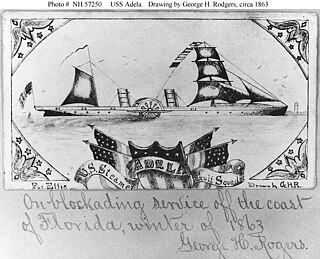
USS Hendrick Hudson was a schooner-rigged screw steamer captured by the Union Navy during the American Civil War. She was used by the Navy as a gunboat in support of the Union blockade of the ports of the Confederate States of America.

USS Sciota was a Unadilla-class gunboat built on behalf of the United States Navy for service during the Civil War. She was outfitted as a gunboat, with both a 20-pounder rifle for horizontal firing, and two howitzers for shore bombardment, and assigned to the Union blockade of the waterways of the Confederate States of America.

USS Stars and Stripes was a 407-ton steamer acquired by the U.S. Navy and put to use by the Union during the American Civil War.

USS Sagamore was a Unadilla-class gunboat built on behalf of the United States Navy for service during the American Civil War. She was outfitted as a gunboat and assigned to the Union blockade of the Confederate States of America. Sagamore was very active during the war, and served the Union both as a patrol ship and a bombardment vessel.

USS Quaker City was a heavy, 1,428 long tons (1,451 t) sidewheel steamship leased by the Union Navy at the start of the American Civil War. She was subsequently purchased by the navy, outfitted with a powerful 20-pounder long rifle, and assigned to help enforce the Union blockade of the ports of the Confederate States of America.
USS Samuel Rotan was a schooner acquired by the Union Navy during the American Civil War. She was outfitted by the Union Navy as a gunboat to patrol navigable waterways of the Confederacy to prevent the South from trading with other countries. Prior to the war, the US Navy had mostly large, deep draft, oceangoing vessels. The establishment of the Union blockade required small, fast, shallow draft vessels like the Samuel Rotan for littoral operations.
USS Two Sisters was a small 54-ton captured Confederate schooner acquired by the Union Navy from the prize court during the American Civil War.
USS Ariel was a captured Confederate schooner acquired by the Union Navy from the prize court during the American Civil War. She was put into service by the Union Navy to patrol navigable waterways of the Confederacy to prevent the South from trading with other countries.
USS Sunflower was a 294-ton steamer acquired by the Union Navy during the American Civil War.

USS Huntsville was a steamer acquired by the Union Navy during the American Civil War. She was used by the Navy to patrol navigable waterways of the Confederacy to prevent the South from trading with other countries.
USS Restless was a barque acquired by the Union Navy during the American Civil War.
USS Roebuck was a barque used by the Union Navy during the American Civil War.
USS William G. Anderson was a barque used by the Union Navy during the American Civil War. She was assigned by the Navy to patrol navigable waterways of the Confederacy to prevent the South from trading with other countries.
USS Tioga was a large steamer with powerful guns, acquired by the Union Navy during the American Civil War.

USS Adela was a steamer captured by the Union Navy during the American Civil War. She was used by the Union Navy as a gunboat in support of the Union Navy blockade of Confederate waterways.

USS Tahoma was a Unadilla-class gunboat built by order of the United States Navy for service during the American Civil War.
USS Kittatinny was a schooner acquired by the Union Navy during the American Civil War. She was used by the Union Navy as a gunboat in support of the Union Navy blockade of Confederate waterways.
USS Annie was a schooner captured by the Union Navy during the American Civil War. She was used by the Union Navy as a ship's tender in support of the Union Navy blockade of Confederate waterways. Her service during the Union naval blockade of Confederate waters peaked during the Second Chesapeake Affair (1863–64) as a "fresh reinforcement from the south" in the search and capture of the U.S.S Chesapeake.

The first USS Wanderer was a high-speed schooner originally built for pleasure. It was used in 1858 to illegally import slaves from Africa. It was seized for service with the United States Navy during the American Civil War. In U.S. Navy service from 1861 to 1865, and under outright U.S. Navy ownership from 1863 to 1865, she was used by the Union Navy as a gunboat, as a tender, and as a hospital ship. She was decommissioned, put into merchant use, and lost off Cuba in 1871.

John Cummings Howell was an officer in the United States Navy during the American Civil War. He rose to the rank of rear admiral and late in his career was commander-in-chief of the North Atlantic Squadron and then of the European Squadron.









